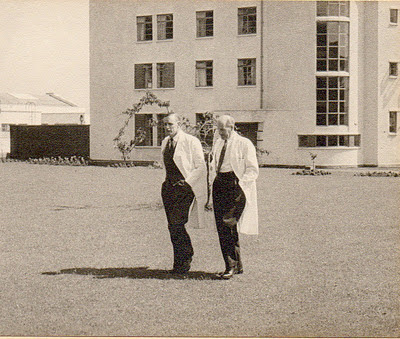
Dr Len West ( right) with Dr Hugh Richmond and a radiologist.
I am grateful to Rosie West, daughter of Australian doctor Len West, for providing information on her father, Len West, who played such a pivotal role in pioneering medical research at Sully.
He was at Sully from 1948 until his tragic early death in 1970 from lung cancer at 59 years of age.
Rosie says:
“Like so many doctors of that time he smoked."
She recalls going to Sully on Saturdays while her father attended to work. "I also went to the children's parties."
She remembers meeting Dr Foreman, the New Zealand medical superintendent and Dilwyn Thomas the surgeon.

Dr Bill Foreman (left) and Dr Len West walking in the grounds of Sully hospital ( circa 1960s).
This obituary appeared in the British Medical Journal on 15 August 1970.
“Dr.L.R. West, consultant chest physician, Sully hospital, Penarth, Glamorgan, died on 11 July at the age of 59.
Leonard Roy West, a South Australian from a medical family, was born on 20 May 1911.
He received his medical education at Adelaide University, graduating M.B., B.S in 1935.
After some jobs in Adelaide he came to London to work for his M.R.C.P, which he took in 1937.
He had house physician posts at he Brompton Hospital and King Edward V11 Sanatorium in Midhdurst before enlisting in the R.A.M.C in 1941.
During his military service he was in Gibraltar, and joined the 6th Airborne Division, which landed in France on D-Day. At the crossing of the Rhine he was mentioned in dispatches,
After demobilization he went back to Midhdurst and in 1947 was appointed chest physician to Sully hospital, to which he devoted the rest of his life.
He was a member of many learned societies including the Thoracic Society and the Cardiac Society, and he was elected F.R.C.P. in 1967.
Thirty years of living in Britain had no effects on the Australian characteristics of Len West. He was enterprising, competent and interested in science to an extraordinary degree.

Len West and Bill Foreman with the team of doctors at Sully hospital.
“Science is measurement” was his motto and he never fell short of it, whether it was in building the first tomography apparatus at Midhurst or making the equipment for and performing the first cardiac catheterization in Wales.
Constructing highly sophisticated electronic apparatus for clinical and research investigations were among the many activities t which he excelled, and undoubtedly it was he who laid the foundations of specialized cardio-thoracic work in Wales.
In addition he was a good teacher and lecturer as well as a sound clinician.
Len West will be well remembered by his many friends for his impish humour, for his bravery, which was exemplified during his long and painful illness, and for his outstanding ability as a chest physician, scientist m an engineer.
His memory will extend far outside the immediate area of his work through the many graduates from all pats of the world that he instructed.
He leaves a wife and a son and a daughter.”

This plaque was placed on the building where Dr West and others did experiments on sheep.


